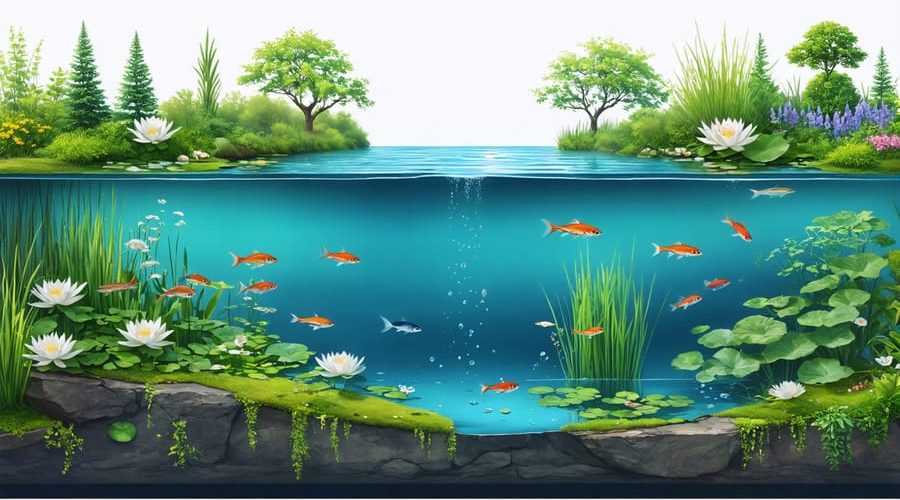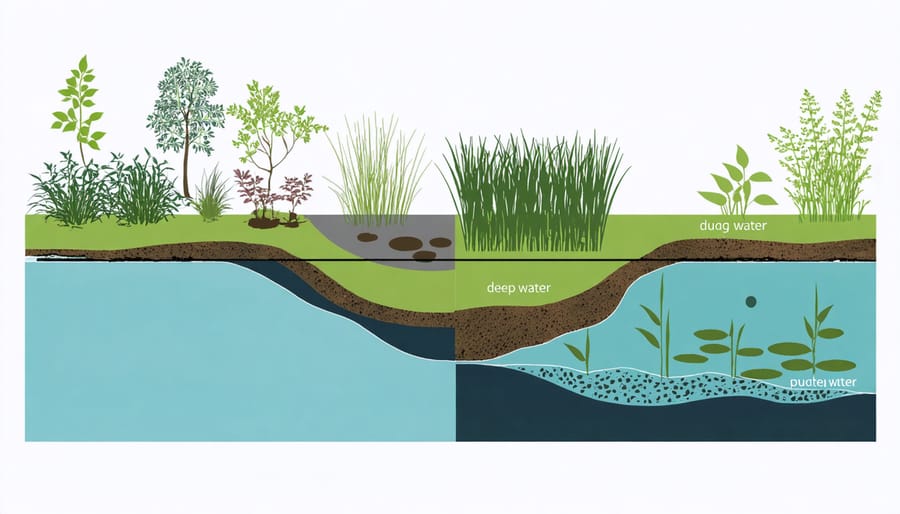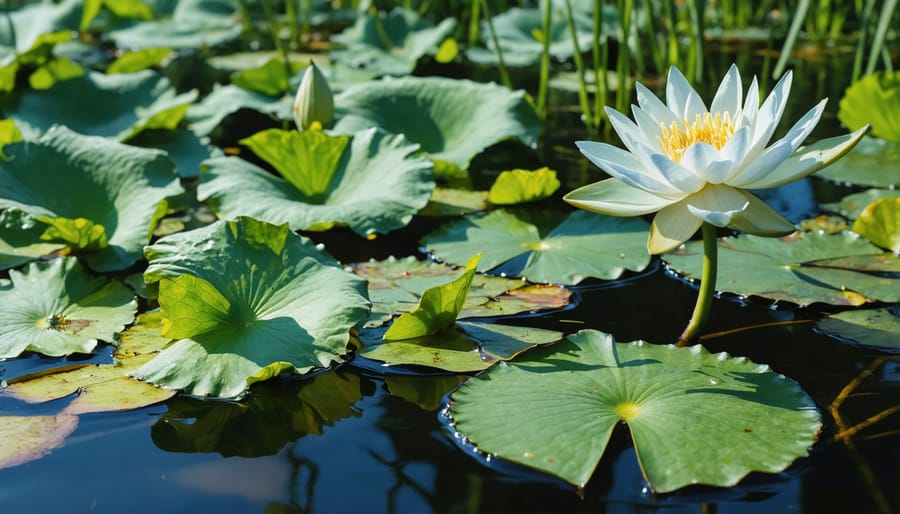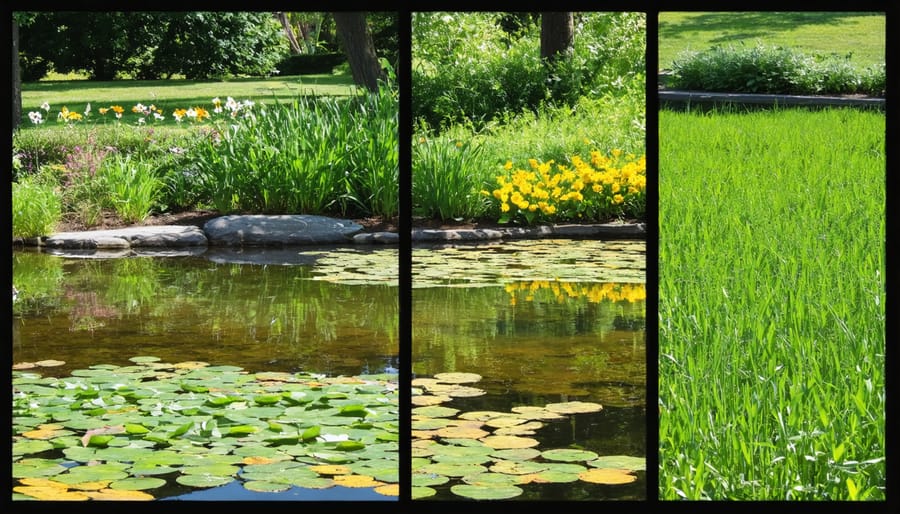
Transform Your Pond into a Thriving Ecosystem with These Game-Changing Plants
Transform your backyard pond into a vibrant self-sustaining pond ecosystem by strategically incorporating aquatic plants across four distinct zones. Deep-water plants like water lilies anchor the pond’s center, providing essential shade and protection for fish. Marginal plants such as rushes and iris create critical transitional areas where wildlife thrives, while floating plants like water lettuce naturally filter excess nutrients. Submerged oxygenators work beneath the surface, maintaining crystal-clear water and supporting beneficial microorganisms.
Creating a balanced pond habitat isn’t just about aesthetics – it’s about building a living system where each plant plays a vital role. From providing shelter for pond inhabitants to controlling algae growth naturally, carefully selected aquatic plants form the foundation of a healthy water garden. Whether you’re establishing a new pond or enhancing an existing one, understanding how to combine these plant types will determine your success in creating a thriving aquatic environment that practically maintains itself.

Essential Zones for Strategic Plant Placement
Marginal Plant Zone
The marginal plant zone, also known as the bog area, is where the magic of ecosystem pond building truly comes to life. This shallow area, typically 0-6 inches deep, creates a gentle transition between your pond and the surrounding landscape. Here, you’ll find a diverse array of plants that thrive with their roots in wet soil or shallow water while their foliage remains above the surface.
Popular marginal plants include iris, rushes, and cattails, which not only add visual interest but also provide essential cover for wildlife. These plants work overtime, helping to filter excess nutrients from the water while their strong roots help stabilize the pond’s edge. For year-round interest, consider mixing plants with different blooming periods – marsh marigolds for spring color, purple loosestrife for summer display, and ornamental grasses for winter texture.
When planting this zone, use sturdy containers with plenty of drainage holes and heavy clay-based aquatic compost. Position taller plants towards the back and shorter varieties in front to create a natural-looking display that frames your pond beautifully.
Deep Water Zone
The deep water zone, typically 2-4 feet deep, is home to some of the most dramatic and beautiful pond plants. Water lilies are the stars of this zone, with their stunning flowers and large floating leaves that provide essential shade for fish and help control algae growth. Hardy water lilies come in shades of pink, white, yellow, and red, while tropical varieties offer even more vibrant colors and extended blooming periods.
Submerged oxygenating plants like hornwort and anacharis are essential additions to the deep water zone. These plants release oxygen into the water during daylight hours and help maintain water clarity by absorbing excess nutrients. Lotus plants are another showstopping option, with their majestic flowers rising several feet above the water’s surface on strong stems.
When planting in the deep water zone, use special planting baskets or containers that can be lowered to the bottom. Start with the containers closer to the surface and gradually lower them over several weeks to help plants adjust to deeper water conditions. Remember that most deep water plants require at least 5-6 hours of direct sunlight daily for optimal growth and flowering.
Top-Performing Plants for Each Zone
Oxygenating Superstars
Underwater oxygenating plants are the unsung heroes of a healthy pond ecosystem. These aquatic powerhouses work tirelessly beneath the surface, releasing oxygen during photosynthesis and helping maintain crystal-clear water. The standout performer is Hornwort (Ceratophyllum demersum), which thrives in various depths and produces oxygen year-round. Its feathery leaves also provide excellent shelter for fish fry and aquatic insects.
Another fantastic choice is Canadian Waterweed (Elodea canadensis), which creates dense underwater forests that naturally filter the water while pumping out oxygen. For those seeking a native option, American Waterweed (Elodea nuttallii) offers similar benefits with a lighter environmental footprint.
Water Milfoil (Myriophyllum spicatum) is particularly effective at absorbing excess nutrients that could otherwise feed unwanted algae. Its delicate, feather-like foliage adds visual interest below the waterline while working hard to keep your pond balanced.
Don’t overlook Fanwort (Cabomba caroliniana), which not only oxygenates effectively but also sports lovely fan-shaped leaves that wave gracefully in the current. For smaller ponds, consider Anacharis, a low-maintenance option that grows quickly and adapts well to various water conditions.
For best results, aim to cover about 50-60% of your pond’s surface area with these oxygenating plants, mixing different species to create a diverse and resilient underwater garden.
Floating Beauty Champions
Floating plants are the jewels of any pond, creating a stunning display while serving essential functions in your water garden. Water lilies reign supreme among these beauties, with their elegant blooms in shades of pink, white, yellow, and purple floating gracefully on the water’s surface. Their broad leaves provide essential shade for fish and help control algae growth by limiting sunlight penetration.
For smaller ponds, water lettuce offers a charming alternative with its rosettes of velvety leaves that form attractive floating colonies. These easy-to-grow plants help keep water temperatures stable and provide excellent cover for pond inhabitants. Another popular choice is duckweed, nature’s smallest flowering plant, which creates a lovely green carpet on the water’s surface and serves as a natural water purifier.
Water hyacinths are particularly striking with their lavender flowers and glossy green leaves. These rapid growers not only add visual interest but also excel at removing excess nutrients from the water. Floating heart plants offer heart-shaped leaves and delicate yellow flowers that bloom throughout summer, perfect for adding a romantic touch to your pond.
When choosing floating plants, remember to cover only about 60% of your pond’s surface to maintain proper oxygen exchange and allow enough light for submerged plants. These floating beauties require minimal maintenance – simply remove excess growth periodically to prevent overcrowding.

Edge Enhancement Heroes
The edge of your pond is prime real estate for creating stunning visual impact while supporting local wildlife. These margin-loving plants not only soften the transition between water and land but also provide essential cover for pond inhabitants and visiting creatures alike.
Iris pseudacorus, commonly known as Yellow Flag Iris, makes a bold statement with its bright yellow blooms and can grow up to 4 feet tall. Plant these stunning flowers in spring for a summer show that butterflies and dragonflies can’t resist. Purple Loosestrife offers similar vertical interest with its spikes of magenta flowers, though it’s important to choose sterile cultivars to prevent spreading.
For lower-growing options, consider Marsh Marigold with its cheerful yellow flowers that bloom in early spring, providing early-season nectar for emerging insects. Rushes and sedges add texture and movement while offering perfect hiding spots for small amphibians and beneficial insects.
Don’t forget about Cardinal Flower, whose brilliant red spikes are absolute magnets for hummingbirds. For late-season interest, Joe-Pye Weed produces large pink flower clusters that attract butterflies and creates excellent winter interest with its dried seedheads.
These edge enhancement heroes not only create a seamless blend between your pond and garden but also help stabilize the soil around your pond’s margin. Remember to plant in groups for maximum visual impact and wildlife benefit.
Smart Plant Selection and Maintenance
Climate Considerations
Choosing the right plants for your pond starts with understanding your local climate zone. Different pond plants have varying temperature tolerances and growing seasons, so it’s essential to select species that will thrive in your specific region.
For cold-climate areas (zones 3-6), focus on hardy varieties like Yellow Flag Iris, Cattails, and Water Lilies that can survive winter temperatures. These plants naturally die back during winter and regrow in spring. Consider moving sensitive plants indoors during harsh winters or treating them as annuals.
In moderate climates (zones 7-8), you have more flexibility with plant choices. Most traditional pond plants will thrive, including Water Hyacinth, Pickerelweed, and various Rush species. These zones typically offer a longer growing season, allowing for more diverse plant combinations.
Warm-climate gardeners (zones 9-11) can enjoy tropical varieties year-round, including Lotus, Tropical Water Lilies, and Water Poppies. However, be cautious with aggressive growers that might spread too quickly in longer growing seasons.
Remember to consider your pond’s sun exposure alongside climate factors. Most aquatic plants prefer full sun, but some varieties tolerate partial shade. Also, pay attention to seasonal changes in your area – factors like rainfall patterns and humidity levels can affect plant growth and maintenance needs.
When in doubt, consult local pond suppliers or gardening centers. They often stock plants well-suited to your specific climate and can provide valuable advice about seasonal care requirements.
Year-Round Care Tips
Keeping your pond plants healthy throughout the year requires attention to seasonal changes and specific care routines. Follow these pond maintenance tips to ensure your aquatic garden thrives in every season.
In spring, start by removing dead foliage and dividing overcrowded plants. This is the perfect time to add fertilizer tablets to your pond plants and introduce new specimens as growth begins. Watch for emerging shoots and ensure your plants have enough space to develop.
Summer calls for regular deadheading of spent blooms and removal of yellowing leaves. Keep floating plants in check by removing excess growth, which can overtake the pond surface. Monitor water levels during hot spells and top up when necessary to protect marginal plants.
Fall maintenance focuses on cutting back dying foliage and removing fallen leaves before they sink and decay. Tropical plants should be moved indoors before the first frost, while hardy varieties can remain in deeper water zones where they’ll naturally go dormant.
During winter, protect tender plants by moving them to the deepest part of the pond or bringing them inside. Trim back dead growth but avoid heavy pruning, as this can stress the plants. Remember to break up ice formation to maintain oxygen exchange, but never smash the ice as this can harm hibernating fish and plants.

Problem-Solving with Strategic Planting
Strategic planting can be your best ally in tackling common pond problems naturally. For algae control, consider adding floating plants like water lilies and lotus, which shade the water surface and compete with algae for nutrients. These beautiful additions not only solve problems but enhance your pond’s aesthetic appeal.
Excess nutrients causing water quality issues? Bog plants and marginals like cattails and rushes act as natural filters, absorbing excess nutrients through their roots. Place these plants where water enters your pond to create a natural filtration system that promotes smart pond management.
Struggling with erosion around pond edges? Deep-rooted marginal plants like iris and sedges help stabilize banks while creating attractive borders. For privacy concerns, tall plants like umbrella grass or bamboo can form natural screens while contributing to the ecosystem.
Fish-friendly environments can be created by incorporating submerged plants like hornwort, which provides shelter and spawning areas. These plants also help maintain oxygen levels and reduce stress on pond inhabitants.
Remember to maintain a balance – aim for about 60% plant coverage to keep your pond healthy without overcrowding. By choosing the right plants for specific challenges, you’ll create a self-sustaining ecosystem that requires less intervention over time.
Creating a thriving pond habitat with the right mix of plants is both rewarding and achievable for any garden enthusiast. By incorporating various plant types across different zones – from deep-water plants to marginal vegetation – you’ll establish a self-sustaining ecosystem that benefits wildlife and enhances your outdoor space. Remember that successful pond planting isn’t just about aesthetics; it’s about creating balance and harmony in your water garden.
Start small and gradually expand your plant collection as you gain confidence. Choose native species when possible, as they’re typically hardier and better suited to your local climate. Don’t forget to maintain proper plant coverage (about 60% of the water surface) to help control algae and provide shelter for pond inhabitants.
Whether you’re a beginner or an experienced gardener, enhancing your pond with carefully selected plants will transform it into a vibrant, living ecosystem. Take the first step today by selecting a few hardy starter plants, and watch as your pond develops into a flourishing water garden that brings joy throughout the seasons.
